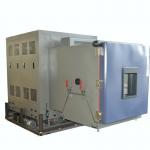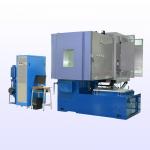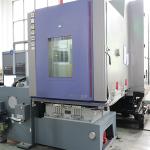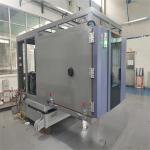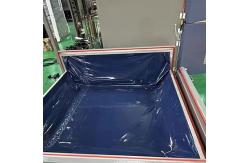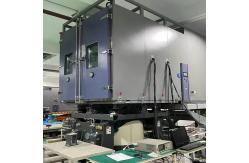In the automotive industry, the reliability and performance of
electrical components are of paramount importance. The HALT HASS
& AGREE Vibration Test Chambers, designed to meet GMW3172 for
electrical component testing, play a crucial role in ensuring that
these components can withstand the rigors of real-world operation
and deliver consistent functionality. This state-of-the-art vibration test chamber is dedicated to
subjecting automotive electrical components to a comprehensive
suite of tests in accordance with GMW3172. It serves automotive
manufacturers, Tier 1 suppliers, and research institutions. The
primary objective is to evaluate the durability and integrity of
electrical components such as sensors, connectors, control modules,
and wiring harnesses under various vibration and environmental
conditions. By simulating the harsh vibrations and stresses that
these components may encounter during a vehicle's lifespan,
manufacturers can identify potential weaknesses, optimize designs,
and enhance the overall quality and reliability of automotive
electrical systems. Robust and Shielded Chamber Structure The chamber is constructed with heavy-duty materials that provide
excellent protection against external electromagnetic interference.
The walls are made of conductive and ferromagnetic materials, which
act as a Faraday cage, shielding the internal testing environment
from stray electromagnetic fields. The interior is designed to
accommodate a wide variety of electrical components, with
adjustable racks and fixtures to ensure proper positioning and
secure mounting. The door is equipped with a reliable sealing
mechanism and a viewing window, allowing operators to monitor the
testing process without compromising the integrity of the shielded
environment.
Precision Vibration and Environmental Control Systems
Vibration System: Capable of generating a wide range of vibration
frequencies and amplitudes. It can produce vibrations from 5 Hz to
2000 Hz with amplitudes up to 50 mm. The vibration system is highly
precise, allowing for the programming of complex vibration profiles
to replicate different driving conditions, such as rough roads,
engine vibrations, and high-speed maneuvers. The vibration platform
is also designed to provide uniform vibration distribution across
the test samples, ensuring accurate and consistent testing results.
Temperature and Humidity Control: The chamber can maintain a wide
temperature range, typically from -40°C to +80°C,
with an accuracy of ±0.5°C. The humidity control
range extends from 10% to 95% relative humidity, with an accuracy
of ±3% RH. These environmental controls are essential as
temperature and humidity can significantly affect the performance
and reliability of electrical components. For example, high
humidity can cause corrosion and short circuits, while extreme
temperatures can lead to component failure or altered electrical
characteristics.
Intuitive Control Panel and Data Acquisition Interface
The control panel is user-friendly and allows operators to easily
set and adjust test parameters such as vibration frequency,
amplitude, temperature, humidity, and test duration. It provides
real-time displays of the current environmental conditions and
vibration status, as well as any alarms or warnings. The chamber is
integrated with a comprehensive data acquisition system that
records all relevant test data. This includes vibration waveforms,
temperature and humidity histories, and any observable changes in
the electrical performance of the components. The data can be
stored in a built-in memory or exported to external storage devices
for further analysis. The system can also generate detailed test
reports in various formats.
Safety Features and Alarms
Over-temperature, over-humidity, and over-vibration protection
systems are in place to prevent damage to the chamber and the test
samples. Emergency stop buttons are easily accessible. Alarms are
triggered for abnormal temperature fluctuations, humidity levels,
vibration malfunctions, or any other equipment failures. The
chamber is also equipped with proper ventilation and exhaust
systems to handle any potentially harmful gases or vapors that may
be generated during the testing process. Additionally, the
shielding of the chamber helps protect operators from any
electromagnetic radiation that may be emitted during testing.
Vibration Parameters
The ability to produce vibrations from 5 Hz to 2000 Hz with
amplitudes up to 50 mm allows for a comprehensive evaluation of
electrical components. Low-frequency vibrations can mimic the slow
oscillations caused by engine idling or driving on a bumpy road,
while high-frequency vibrations can replicate the rapid vibrations
associated with high-speed rotating components or electrical
switching. The precise control of vibration frequency and amplitude
is crucial for identifying potential resonance points and
weaknesses in the components.
Temperature and Humidity Ranges and Accuracies
The -40°C to +80°C temperature range with
±0.5°C accuracy and 10% to 95% RH humidity range
with ±3% RH accuracy provide a wide spectrum of
environmental conditions for testing. Electrical components must be
able to function reliably across different climates and operating
conditions. For instance, a sensor used in a vehicle's engine
compartment may experience high temperatures, while a component in
the interior may be subject to more moderate temperature and
humidity levels. The accurate control of these parameters ensures
that the test conditions are realistic and repeatable.
Testing Volume and Payload Capacity
The chamber offers a customizable testing volume, usually ranging
from 3 m³ to 15 m³, depending on the size and
quantity of electrical components to be tested. The payload
capacity is designed to handle a significant amount of components,
with a maximum capacity of up to several tons. This flexibility
allows for efficient testing of both individual components and
complex assemblies.
Data Sampling Frequency and Resolution
The data acquisition system samples data at a frequency of up to
1000 Hz. The vibration data has a resolution of 0.1 Hz and 0.1 mm
for frequency and amplitude respectively. The temperature data has
a resolution of 0.1°C, and the humidity data has a
resolution of 0.1% RH. This high-resolution and frequent sampling
enable the detection of even the slightest changes in the test
conditions and component performance, providing valuable insights
for analysis and improvement.
Accurate Simulation of Real-World Conditions
The chamber replicates the combined effects of vibration,
temperature, and humidity that automotive electrical components may
face during their service life. By subjecting the components to
these realistic conditions, manufacturers can ensure that they will
perform reliably in the field. For example, a connector that is
prone to loosening under vibration and temperature changes can be
identified and redesigned before it causes issues in a vehicle.
Product Design Optimization and Quality Control
Through a series of tests on different electrical component
prototypes, the data obtained from the chamber can be used to
optimize product designs. Engineers can analyze the performance of
various materials, geometries, and manufacturing techniques under
the combined stress of vibration, temperature, and humidity. The
chamber also serves as a critical tool for quality control,
ensuring that each production batch of components meets the
required standards. If a particular control module shows signs of
electrical instability during testing, the design or manufacturing
process can be adjusted to correct the issue.
Research and Development Support
In the field of automotive electrical component research and
development, the HALT HASS & AGREE Vibration Test Chambers
offer valuable insights. Researchers can use it to study the
fundamental properties of new materials and their interactions with
vibration, temperature, and hum
|
